Biodynamic wines are wines made employing the biodynamic methods both to grow the fruit and during the post-harvest processing. Biodynamic wine production uses organic farming methods while also employing soil supplements prepared according to Rudolf Steiner's formulas, following a planting calendar that depends upon astrological configurations, and treating the earth as "a living and receptive organism."
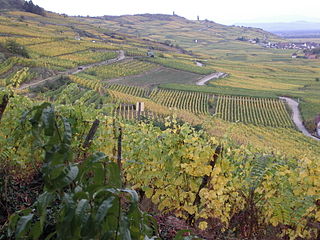
Alsace wine or Alsatian wine is produced in the Alsace region in France and is primarily white wine. Because of its Germanic influence, it is the only Appellation d'Origine Contrôlée region in France to produce mostly varietal wines, typically from similar grape varieties to those used in German wine. Along with Austria and Germany, it produces some of the most noted dry Rieslings in the world as well as highly aromatic Gewürztraminer wines. Wines are produced under three different AOCs: Alsace AOC for white, rosé and red wines, Alsace Grand Cru AOC for white wines from certain classified vineyards and Crémant d'Alsace AOC for sparkling wines. Both dry and sweet white wines are produced.
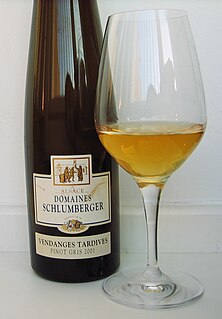
Vendange tardive ("VT") means "late harvest" in French. The phrase refers to a style of dessert wine where the grapes are allowed to hang on the vine until they start to dehydrate. This process, called passerillage, concentrates the sugars in the juice and changes the flavours within it. The name is sometimes written as the plural form, vendanges tardives, referring to the fact that several runs through the vineyard is often necessary to produce such wines. In other countries such as Germany or Austria the term Spätlese is used to describe wine using the same making process.

Chambertin is an Appellation d'origine contrôlée (AOC) and Grand Cru vineyard for red wine in the Côte de Nuits subregion of Burgundy, with Pinot noir as the main grape variety. Chambertin is located within the commune of Gevrey-Chambertin, and it is situated approximately in the centre of a group of nine Grand Cru vineyards all having "Chambertin" as part of their name. The other eight vineyards, which all are separate AOCs, have hyphenated names where Chambertin appears with a prefix, such as Chapelle-Chambertin. Chambertin itself is situated above the Route des Grands Crus. It borders on Chambertin-Clos de Bèze in the north, Griotte-Chambertin and Charmes-Chambertin in the east and the Latricières-Chambertin in the south. The AOC was created in 1937.
The glossary of wine terms lists the definitions of many general terms used within the wine industry. For terms specific to viticulture, winemaking, grape varieties, and wine tasting, see the topic specific list in the "See also" section below.

Romanée-Conti is an Appellation d'origine contrôlée (AOC) and Grand Cru vineyard for red wine in the Côte de Nuits subregion of Burgundy, France, with Pinot noir as the primary grape variety. It is situated within the commune of Vosne-Romanée and is a monopole of the winery Société Civile du Domaine de la Romanée-Conti, which takes its name after this vineyard. Romanée-Conti borders on La Romanée in the west, Richebourg in the north, Romanée-Saint-Vivant in the east and La Grande Rue in the south. The AOC was created in 1936.
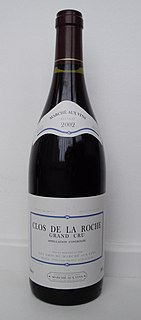
Clos de la Roche is an Appellation d'origine contrôlée for red wine in the Côte de Nuits subregion of Burgundy, with Pinot noir as the main grape variety. It is situated in the commune of Morey-Saint-Denis in the Côte-d'Or département. Clos de la Roche is located in the northern part of the commune, stretches to the border of Gevrey-Chambertin, and borders to the Grand Cru vineyard Clos Saint-Denis in the south. It borders the Route des Grands Crus in the east. The AOC was created in 1936, and the Clos part of its name refers to a wall-enclosed vineyard.

Clos des Lambrays is an Appellation d'origine contrôlée (AOC) and Grand Cru vineyard for red wine in the Côte de Nuits subregion of Burgundy, with Pinot noir as the main grape variety. It is situated in the commune of Morey-Saint-Denis in the Côte-d'Or département, and is located immediately to the southwest of the village Morey-Saint-Denis. The Clos part of its name refers to a wall-enclosed vineyard. Clos des Lambrays was elevated from premier cru to grand cru status in 1981, which meant that it was created as a separate AOC.
Sélection de Grains Nobles (SGN) is French for "selection of noble berries" and refers to wines made from grapes affected by noble rot. SGN wines are sweet dessert wines with rich, concentrated flavours. Alsace wines were the first to be described as Sélection de Grains Nobles, with the legal definition introduced in 1984, but the term is also seen in some other wine regions France, such as Loire.
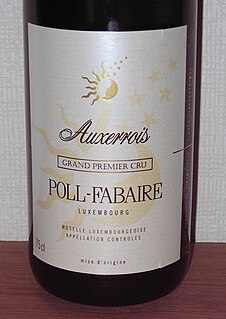
Luxembourg wine is primarily produced in the southeastern part of the Grand Duchy of Luxembourg, with vineyards overlooking the river Moselle. Along this river, which for 42 km makes up part of the border between Luxembourg and Germany, wine is made in three countries. There is a continuous history of winemaking along Moselle and in Luxembourg going back to Ancient Roman times. Wine production in 2006/07 was 123,652 hectoliter from 1,237 hectares of vineyards. Out of total wine exports of 87,776 hectoliter in 2005/06, 71,726 hectoliter or 82% was exported to nearby Belgium. Exports to Germany were the second largest at 8,168 hectoliter, or 9%, and is to a large extent made up of base wine in bulk for the production of blended Sekt rather than being sold bottled with "Luxembourg" anywhere on the label. Therefore, very little Luxembourg wine is seen outside Luxembourg and Belgium.

Hugel & Fils is a winery in Riquewihr, Alsace, France. Hugel & Fils is one of the major producers of Alsace wine, and has been an important force in the Alsace wine industry in its developments during the second half of the 20th century.

Savennières wine is a white wine, usually dry, produced from Chenin blanc around Savennières in the Loire Valley. The vineyards are situated on the north bank of the river Loire, in the Anjou-Saumur subregion.

The wine region of Alsace produces wines under three different Appellations d'Origine Contrôlées (AOCs): Alsace AOC for white, rosé and red wines, Alsace Grand Cru AOC for white wines from certain classified vineyards and Crémant d'Alsace AOC for sparkling wines. This region is the only French wine region allowed to label its wines based on variety.
Domaine Coche-Dury is a French wine grower and producer. It is based in Meursault, in the Côte de Beaune wine region of Burgundy, France.

Domaine de la Romanée-Conti, often abbreviated to DRC, is an estate in Burgundy, France that produces white and red wine. It is widely considered among the world's greatest wine producers, and DRC bottles are among the world's most expensive. It takes its name from the domaine's most famous vineyard, Romanée-Conti.
Marcel Deiss is a French wine grower and producer. It is based in Bergheim, in the Alsace wine region of France.
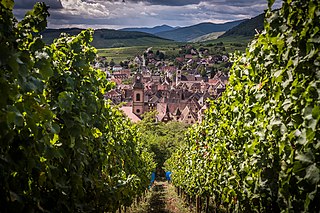
The Alsatian Grand Cru vineyard Schoenenbourg is situated north of the village Riquewihr. The vineyard faces south and south-east on the steep hill Schoenenbourg. The altitude of the vines are between 265 and 380 meters and covers 53.4 ha og Keuper subsoil with marl, gypsum and dolomite.

Domaine Ponsot is a wine producer in Burgundy, France that produces white and red wine. They are best known for their Morey-Saint-Denis Blanc 1er cru Clos des Monts Luisants — the only premier cru Burgundy made entirely from Aligoté — and their flagship reds, the Clos de la Roche Cuvée Vieilles Vignes, and the Clos St. Denis Cuvée Très Vieilles Vignes. The domaine's wine was famously counterfeited in the Wine Auction Scandal that resulted in Rudy Kurniawan's arrest.
Domaine Dujac is a Burgundy wine producer run by the Seysses family. The founder, Jacques Seysses, is still involved in its operation. His sons, Jeremy and Alec, and Jeremy's wife Diana have run the domaine for the past several vintages. Jacques founded the domaine in 1967, and the first release was 1969. Up until 1999, all the wines from the domaine were whole cluster pressed, with all new oak barrels used.
Domaine de la Vougeraie is a Burgundy wine producer in the town of Premeaux-Prissey, France. They produce wine from vineyards in the Côte de Nuits and the Côte de Beaune.













